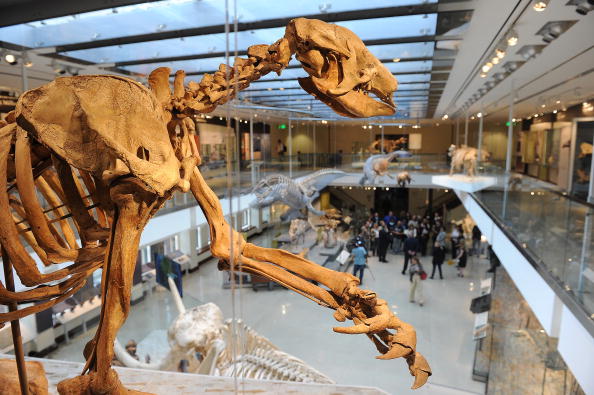During the Pleistocene era, Santa Cruz County was a wild place with ancient humans and large creatures like mastodons and mammoths. It wasn't known that massive ground sloths roamed the region until a group of kids from the Tara Redwood School in Soquel found a mysterious fossil and brought it to the Santa Cruz Museum of Natural History.
The Executive Director of the Santa Cruz Museum of Natural History, Felicia Van Stolk, said they learned about this discovery around the same time as the mastodon frenzy in the community. Their paleontology adviser Wayne Thompson was really excited about this specimen, indicating that it was significant.
According to Van Stolk, a group of young kids from Tara Redwood School found the fossilized bone while playing outside in the Santa Cruz Mountains during a field trip.
Van Stolk said one of the students found the large fossil which was mistaken for a stick. The students later brought it to their classroom and pretended to be paleontologists while cleaning it with paint brushes.
The bone stayed in the classroom briefly before the family of one of the young citizen scientists decided to take it to the Museum of Natural History for identification. Thompson and Van Stolk suspected it might be part of an ancient sloth and later confirmed it as such after some investigation.
Van Stolk said they used their resources and connections to confirm it as a very rare specimen, and they were extremely happy about it.
Thompson, a principal paleontologist, has been involved with ancient creatures since he was a boy. The bone has been identified as the left radius bone of a Jefferson’s ground sloth and is the first of its kind ever found in the county. The exact age of the specimen is still being determined.
Thompson mentioned that the bone is from a Jefferson’s ground sloth, named after Thomas Jefferson, and is the first of its kind found in the county. The exact age of the specimen is still being determined.
Thompson explained that the age of the bone is still being determined. They are waiting for data from the testing facility, and are considering various methods to determine its age.
Thompson said that Jefferson’s ground sloths lived in California from about 300,000 years ago to about 11,700 years ago, and it is rare to find remnants of their existence.
In my research, I have found that this is the largest bone that has been recorded so far. It is from an adult male because the ends of the bone are fused, indicating full maturity,
Jefferson’s ground sloths lived near creeks and rivers, under canopy forests, and were about the size of an ox, usually weighing over a ton. When not in caves, they would roam around, sometimes standing on their hind legs and using their long claws to strip leaves from tree branches like spruce and alderwood.
Compared to mammoths that were grazers in grasslands, these sloths were browsers. They were about 6 feet tall on all fours and could reach 8 to 9 feet tall when standing up,
The sloth fossil adds to the incomplete picture of ancient Santa Cruz, which would have had a coastline located miles further out than its current location, according to Thompson.
Thompson explained that the ice age caused Santa Cruz to be larger, and mammoth fossils have been found in the bay.
Thompson mentioned that he was excited about the rare specimen and the fact that it was the first of its kind in the county, and that it was discovered by a group of young kids. He also provided advice for those inspired to go on their own fossil-finding mission.
The important thing to remember is to research and know the regulations of the area before fossil hunting. It is generally illegal to take artifacts from public land unless they are in danger of destruction. Always document findings with photographs, report them to a museum, and be enthusiastic about the potential for discovery.
The fossilized arm bone of the Jefferson’s ground sloth is displayed in the museum's current exhibition called “The Art of Nature” until May 26, featuring scientific illustrations from 40 local artists depicting extinct megafauna such as the ground sloth.
For more information, please visit santacruzmuseum.org.









